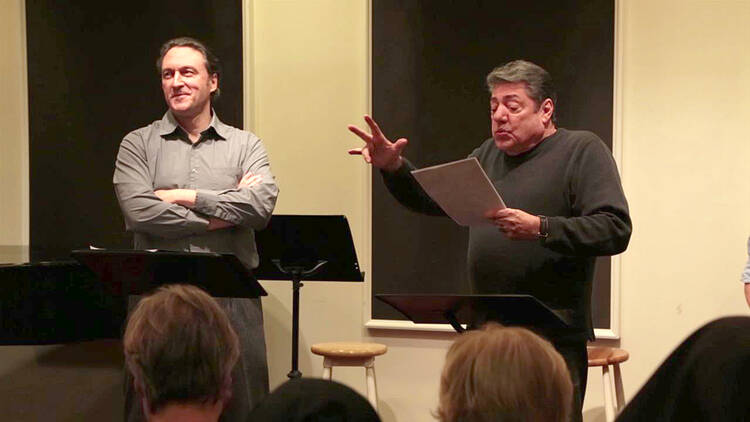This spring I attended a dramatic reading of the 1928 novel “Mr. Blue,” written by Myles Connolly. The book was required reading when I was in high school, and the staged reading was directed by a longtime Jesuit friend of mine, the multitalented George Drance, S.J., so I was eager to attend this event. It was held in a performance space of the Dramatists Guild of America in the historic Paramount Building in Times Square, which included the studios of Tin Pan Alley, from which thousands of great popular songs emerged over many years.
George was the narrator of the piece, working with three other excellent actors—John Roney, Tess Roney and Richard Zavaglia—from the St. Genesius Society housed at St. Malachy’s Church in the Broadway theater district, which includes The Actors’ Chapel. The pianist, Brian Drutman, entertained the audience before the play with music from the 1920s. This was a break from his daytime job of recording original cast albums of Broadway shows, including Grammy Award winners like “Monty Python’s Spamalot,” “Wicked,” and “Spring Awakening.” Mary Kay Williams, a respected playwright and adaptor, did an excellent job of distilling the book into a one-hour reading.
The short novel tells the story of Mr. Blue, a New Yorker who, when we first meet him, is living on the rooftop of a tall building in a tent that displays a sign that just says HOPE. His lifestyle (if we can call it that) is a product of his devotion to freedom and imagination, by which Mr. Blue declares that “anything is possible.” At one point in the story, he inherits two million dollars from a cousin and moves to Boston where he lives in luxury for a little while—but soon gives away all of his fortune and moves into a lodging connected with a downtown church. He describes the money as “a trial sent me by my lady Poverty. ” He is clearly a radical Christian of the Franciscan variety.
The narrator visits Mr. Blue (played by John Roney) many times for the rest of Mr. Blue’s life. The narrator is constantly surprised by Mr. Blue’s radical ideas and behavior and tries to talk him out of them. I admired how Drance performed the role of the narrator, a thankless task that usually consisted of his arguing with Mr. Blue and questioning his lifestyle, but never succeeding in changing his mind. Drance has enjoyed great success in combining his career as a priest and an actor-director, teaching theater courses for the last sixteen years as an artist-in-residence in the theater department of Fordham University. He has worked extensively with the La Mama Experimental Theater Company in the East Village, where is he now acting in a solo performance of the Gospel of Mark. Drance is also founder of the Magis Theatre Company.
Born in Boston in 1897, Myles Connolly attended Boston College, where he became the editor of the college’s literary magazine and went on to become a reporter for The Boston Post. He soon moved to Hollywood to become a (sometimes uncredited) screenwriter and collaborated with Frank Capra in “State of the Union,” “Mr. Smith Goes to Washington” and “It’s a Wonderful Life.” He also served as the screenwriter for the popular “Tarzan” movies of the 1940s. His last screenplay was for the MGM musical biography, “Hans Christian Anderson,” a big hit starring Danny Kaye. This very respectable career enabled Myles, his wife Agnes and their five children to settle down in Malibu—a far cry from Boston and New York.
“Mr. Blue” became a great success with editions appearing in Brazil, England, Germany, Italy and the Netherlands before Connolly’s death in California in 1964. He left “Mr. Blue” as his greatest legacy. Cardinal Timothy Dolan of New York recently declared that “Mr. Blue” was one of his favorite novels, and John Sexton, the Jesuit-educated president of New York University, said in an interview that “the goal for all of us is to be like Mr. Blue.”
With all those years in Hollywood, one wonders why no one produced a film version of the book. One can easily imagine Jimmy Stewart, Henry Fonda or Danny Kaye as the star. Connolly’s daughter Mary, who attended the reading, said that it was something of a mystery to her also why that never happened, but she mentioned the rumor that someone has recently bought the rights to the book. So who knows? We may get to see Tom Hanks, Ben Affleck or Robin Williams in the role. We can only imagine what Phillip Seymour Hoffman would have done with it. Meanwhile, we can dust the book off from our bookcases or go to our local library to retrieve it, which is what I did, and hope that the movie version will soon appear. Who knows? To quote Mr. Blue himself, “Anything is possible.”








